Yesterday I touched on upcycling and creating your own light fixture with a bunch of design ideas and DIYs. Building a pretty fixture is one thing, but you need to know how to wire/rewire it without electrocuting yourself or burning down your house. We already went over how to rewire a plug in fixture. We are going to go a step farther today.
How many times have you come across a plug in ceiling fixture and passed on it because you didn't want to deal with the hanging cord and would rather have it hard wired right into the ceiling? *crickets* anybody? This is where you are all suppose to sit on the edge of your seat and say "me, me, me!" and make me feel like less of a design nerd. See, it happens to me more than it should, and I collect more light fixtures than I probably should. I also remake and change out my light fixtures way more often than I should.
So lets go over how to turn that plug-in into a hard wired fixture.
 I came across a pair of vintage spaghetti light pendants almost a year ago. I already had one that I retrofitted to be a hardwired light fixture by using a simple IKEA white pendant kit (below left), but I had different ideas for the new pair (below right).
(The fact that I own THREE spaghetti lamps? hoarder.)
I came across a pair of vintage spaghetti light pendants almost a year ago. I already had one that I retrofitted to be a hardwired light fixture by using a simple IKEA white pendant kit (below left), but I had different ideas for the new pair (below right).
(The fact that I own THREE spaghetti lamps? hoarder.)
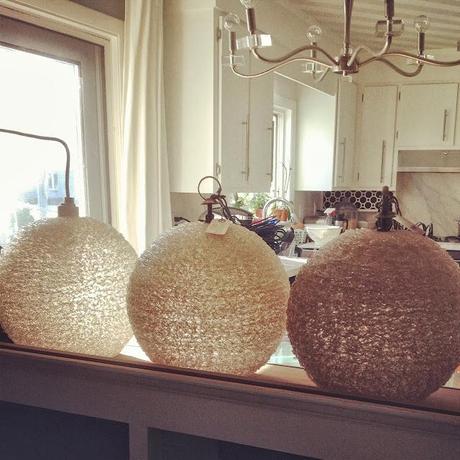 I had a vision in my head.
I kept imagining them encased with brass rings, but I was having a hard time executing the idea until I stumbled upon two of these orbs from Homegoods for $19.99...
I had a vision in my head.
I kept imagining them encased with brass rings, but I was having a hard time executing the idea until I stumbled upon two of these orbs from Homegoods for $19.99...
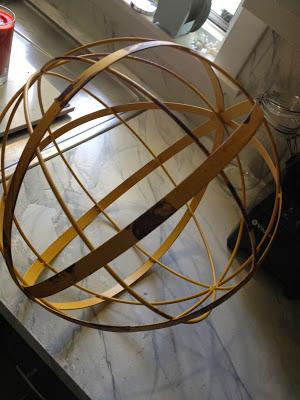 I measured them and they would be a perfect outer casing for the spaghetti lights.
I had no idea how I would get the spaghetti lamps inside them. I just pushed forward and decided I'd cross that road when the time came and if it didn't work it would be back to the drawing board.
It's all "by the seat of my pants" around here.
I sprayed them gold within minutes of bringing them home and hung them from the ceiling.
The scale was good.
My first issue was going to be rewiring the old lights into a hardwired fixture.
I measured them and they would be a perfect outer casing for the spaghetti lights.
I had no idea how I would get the spaghetti lamps inside them. I just pushed forward and decided I'd cross that road when the time came and if it didn't work it would be back to the drawing board.
It's all "by the seat of my pants" around here.
I sprayed them gold within minutes of bringing them home and hung them from the ceiling.
The scale was good.
My first issue was going to be rewiring the old lights into a hardwired fixture.
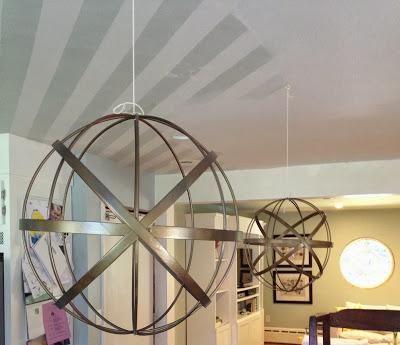 As you can see the old wires and plug were ancient!
Even if I wanted to use this as a plug in fixture I would need to update it.
As you can see the old wires and plug were ancient!
Even if I wanted to use this as a plug in fixture I would need to update it.
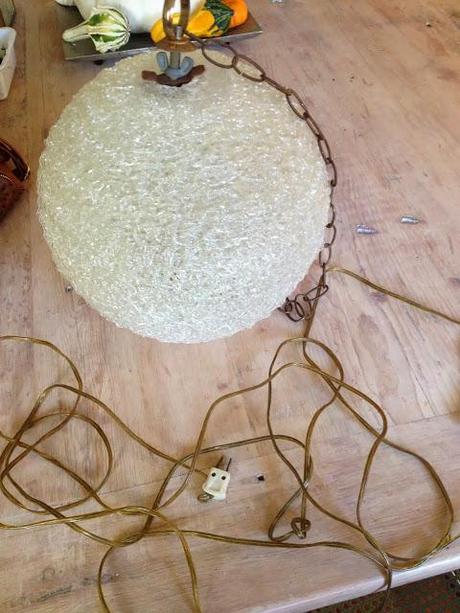
Start by taking your pendant apart and inspecting the pieces.
I like to lay the pieces out in the order I took them apart
and photograph them so I know how to reassemble. Begin making your parts list. I wasn't a fan of the big wing nuts, so I knew I would need smaller brass nuts. I also wanted my bulb to hang a bit lower so I would be swapping out the 2" threaded nipple with a 4" threaded nipple. Figure out what you are keeping and what needs to be rebuilt, make your list and go shopping. I like to bring my parts with me to the store to make sure I get the right sized socket, threaded nipples, etc.
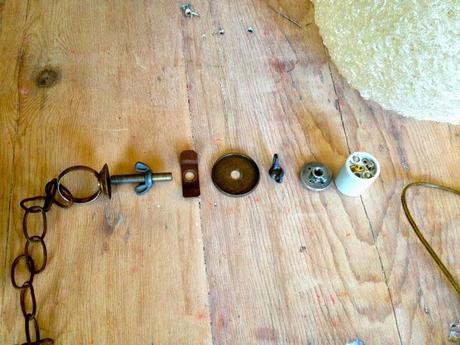 Once again I was off to my local True Value.
On a quick side note, this entire series started off as one lighting post I was working on for True Value and it quickly grew into an entire "Lighting Week". I have to give a big shout out to everyone that helped me at Dawson's True Value in Beverly, MA. I really couldn't have pulled this off without their patience and help. I am not an electrician, so it was very reassuring to have them double check and guide me in proper tools and techniques. Their staff is top notch and so helpful, and I really can't say enough good things about them- so THANK YOU!
Once again I was off to my local True Value.
On a quick side note, this entire series started off as one lighting post I was working on for True Value and it quickly grew into an entire "Lighting Week". I have to give a big shout out to everyone that helped me at Dawson's True Value in Beverly, MA. I really couldn't have pulled this off without their patience and help. I am not an electrician, so it was very reassuring to have them double check and guide me in proper tools and techniques. Their staff is top notch and so helpful, and I really can't say enough good things about them- so THANK YOU!
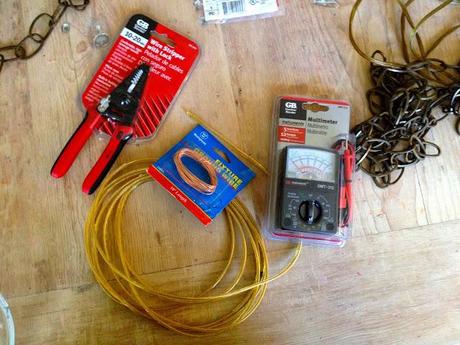 I returned with my replacement parts and supplies.
I returned with my replacement parts and supplies.Depending upon your fixture you will also need: Wire cutters/strippers Needle-nose Pliers
Porcelain Socket New Electrical Lamp Cord (you can buy this by the foot in several colors) Copper Ground Wire Medium Based 250V Porcelain Socket 2 Uninsulated Ring Terminals (one to fit over nipple, other to fit on ground screw) Green Ground Screws Circuit Tester if you are installing yourself
Ceiling Canopy Kit
I measured the length between the ceiling and the top of the pendant and added an extra 16". (My ceiling hasn't been painted yet here, it's a mess.)
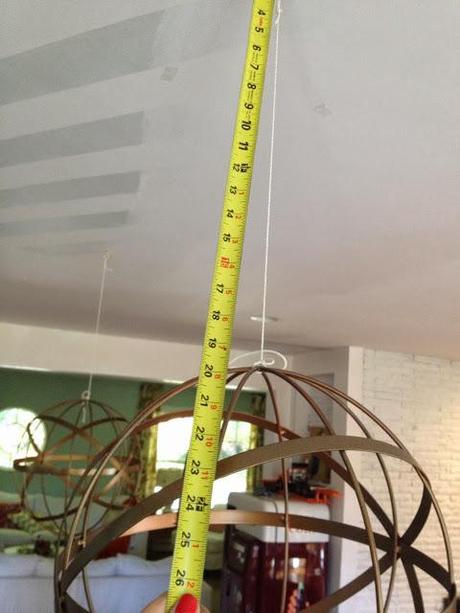 I then cut my electrical wire to that length and stripped the plastic off the ends with my wire strippers.
I then cut my electrical wire to that length and stripped the plastic off the ends with my wire strippers.
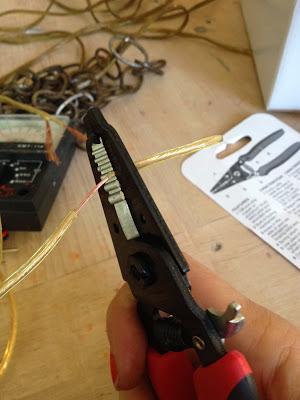 Now its time to rebuild and wire up your light!
Now its time to rebuild and wire up your light!
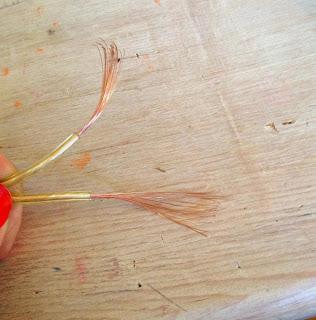 Lets start with the socket.
Feed this wire through the top of the socket and identify your live and neutral wires.
Lets start with the socket.
Feed this wire through the top of the socket and identify your live and neutral wires.
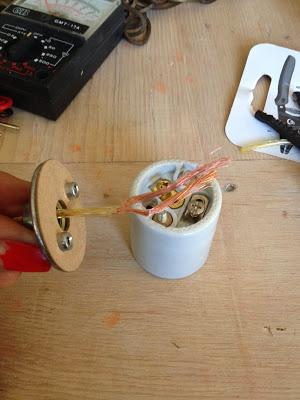 One side of the wire will feel smooth- this is the LIVE side.
One side of the wire will feel smooth- this is the LIVE side.(I highly recommend you mark it with a Sharpie since they look the same and it gets confusing.) The other side of your wire should have a slight ribbing along the side- this is your neutral wire. Attach the live wire to the copper screw and the neutral wire to the silver screw.
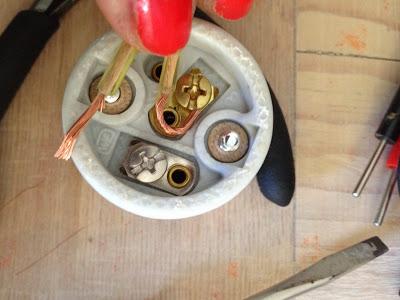 To do this twist the ends of the wire and bend like a candy cane.
Loosen the screws so the wire fits under it and then tighten firmly with a screwdriver.
To do this twist the ends of the wire and bend like a candy cane.
Loosen the screws so the wire fits under it and then tighten firmly with a screwdriver.
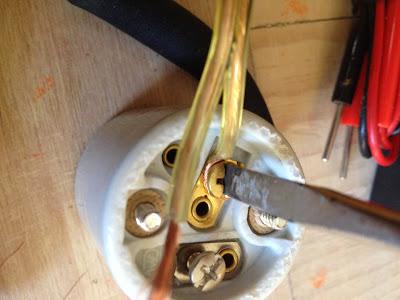 Once you have the wires connected slide the top of the socket cap over them and tighten that on with the included screws. You will be tightening it through the base of the bulb socket.
Once you have the wires connected slide the top of the socket cap over them and tighten that on with the included screws. You will be tightening it through the base of the bulb socket.
 I then slide the 4" nipple over the cord and attached it to the socket.
I then slide the 4" nipple over the cord and attached it to the socket.These instructions may vary depending on the fixture you are rebuilding, so use the photo you took when you disassembled to make sure you put it all back together properly.
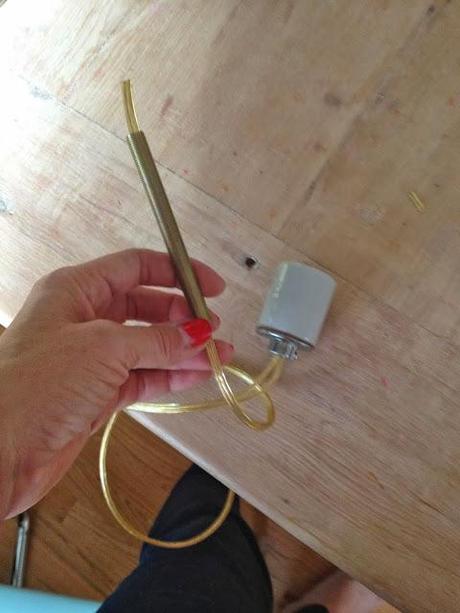 Be sure to tighten the side screw on the socket to ensure it is on tight and wont slip off once it is hung.
Be sure to tighten the side screw on the socket to ensure it is on tight and wont slip off once it is hung.
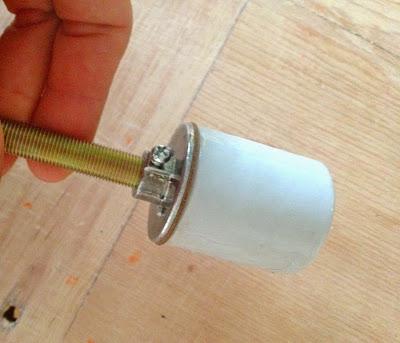 Now you are wired and its time to reassemble the pendant in the order you took it apart.
You will be adding the ground wire as well.
This is VERY important.
Now you are wired and its time to reassemble the pendant in the order you took it apart.
You will be adding the ground wire as well.
This is VERY important.
Many old fixtures are ungrounded which
Let's get grounded.
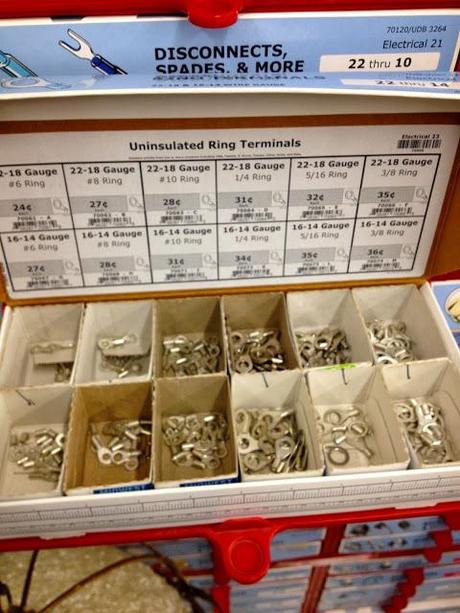 Those are Uninsulated Ring Terminals.
You will want to buy one that fits over a green ground screw and another that fits over your threaded nipple.
Here we are going to be attaching the copper ground wire to the terminal by threading it in and crimping it with pliers...
Those are Uninsulated Ring Terminals.
You will want to buy one that fits over a green ground screw and another that fits over your threaded nipple.
Here we are going to be attaching the copper ground wire to the terminal by threading it in and crimping it with pliers...
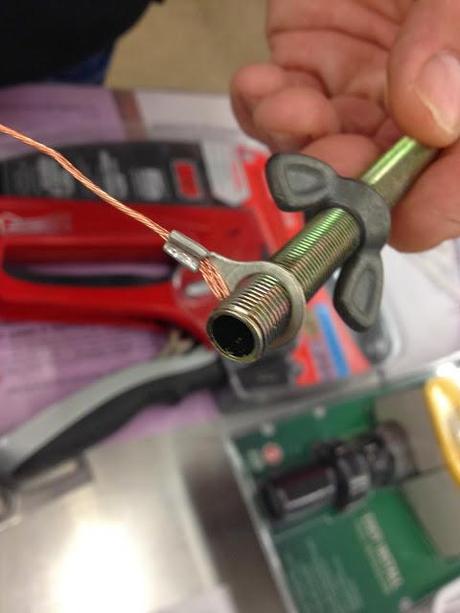 Choose one uninsulated ring terminal that will fit over the threaded nipple,
and the other will fit over the threaded end of a green ground screw...
Choose one uninsulated ring terminal that will fit over the threaded nipple,
and the other will fit over the threaded end of a green ground screw...
 Once the ground wire was connected I slid mine on the threaded nipple near the top of my fixture:
Once the ground wire was connected I slid mine on the threaded nipple near the top of my fixture:
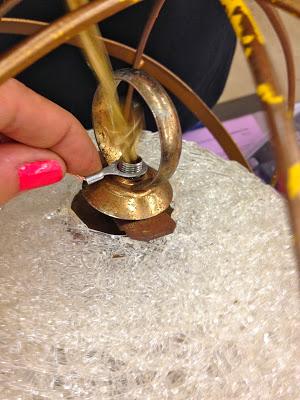 and fastened tightlyit in place tightly with a brass nut.
and fastened tightlyit in place tightly with a brass nut.
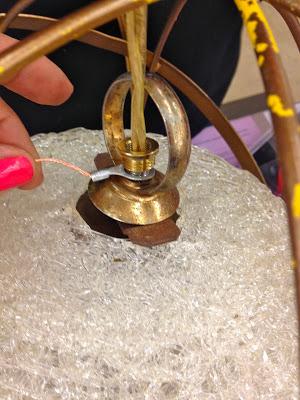 I then bent it upwards and twisted the ground wire around my electrical wire and then threaded all the wire through a new chain.
I then bent it upwards and twisted the ground wire around my electrical wire and then threaded all the wire through a new chain.
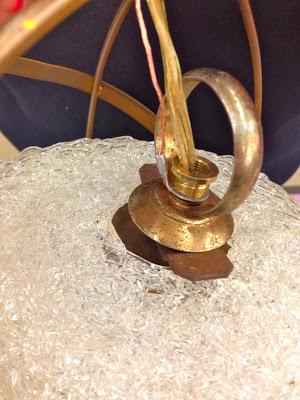 The second terminal will attach to the ground screw on your bracket or electrical box.
The second terminal will attach to the ground screw on your bracket or electrical box.
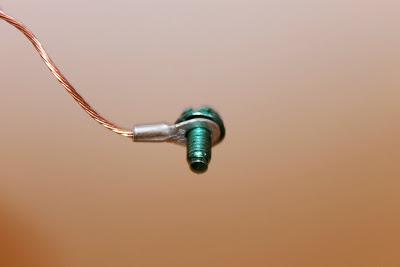
(the hole with the GND next to it is where the green ground screw goes.
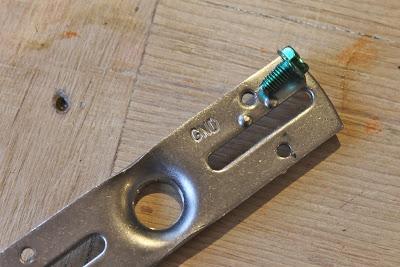 Add your lightbulb and you are ready to install your fixture and light it up!
Here is a little video on hanging your fixture.
It's short and to the point and done by a dude named John who. talks. real. slow.
I would have made you one but I talk way too fast and I can't focus, so it would have been like 15 minutes long. Thanks John.
Add your lightbulb and you are ready to install your fixture and light it up!
Here is a little video on hanging your fixture.
It's short and to the point and done by a dude named John who. talks. real. slow.
I would have made you one but I talk way too fast and I can't focus, so it would have been like 15 minutes long. Thanks John.
And if you rather an electrician hang your light, that is fine too.
Mwah-ha-ha! I felt like Frankenstein with my newly melded lights...
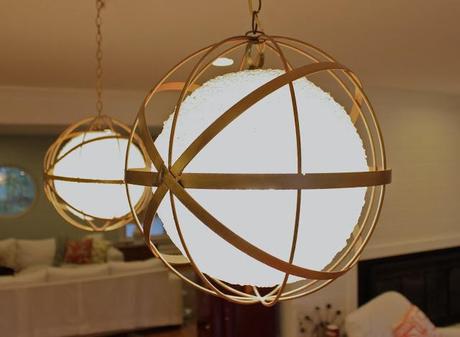
But wait!!! Are you wondering how I got the pendant into the metal orb? My Dad came to the rescue with a crash course in the old "cut and solder". This is a two person job! One needs to hold the orb steady while the other cuts and solders. He used a hacksaw with a fine metal blade to cut through a few areas.
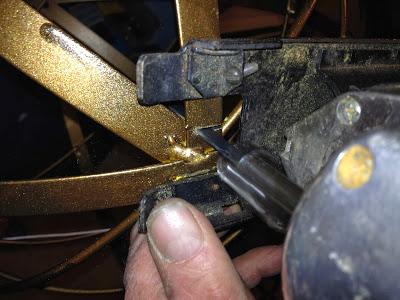 He left 2 pieces attached so we could bend the section back and insert the pendant.
He left 2 pieces attached so we could bend the section back and insert the pendant.
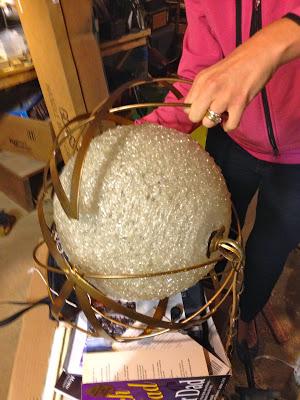 And finally he used an enormous soldering iron to put it back together.
(My little craft soldering iron would have done nothing!) We had to sand off the paint to have clean soldering surfaces.
And finally he used an enormous soldering iron to put it back together.
(My little craft soldering iron would have done nothing!) We had to sand off the paint to have clean soldering surfaces.
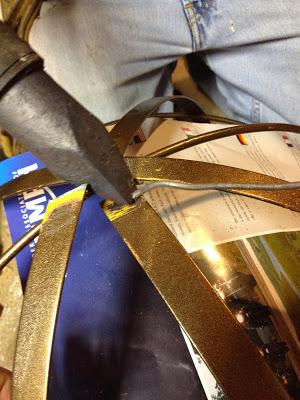 Battle wounds...
Battle wounds...
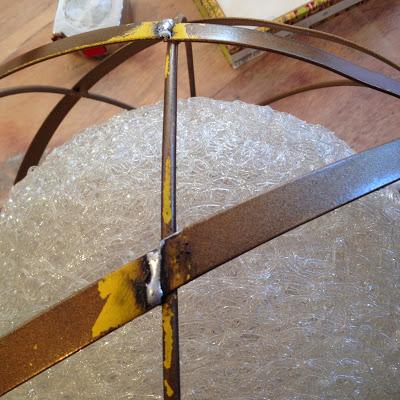 Since spray painting was no longer an option with the pendant now inside,
it was Rub and Buff to the rescue!
Since spray painting was no longer an option with the pendant now inside,
it was Rub and Buff to the rescue!
 Worked pretty well covering the solder scars, and I tried to position my lights to have the majority of the repairs at the top.
Worked pretty well covering the solder scars, and I tried to position my lights to have the majority of the repairs at the top.
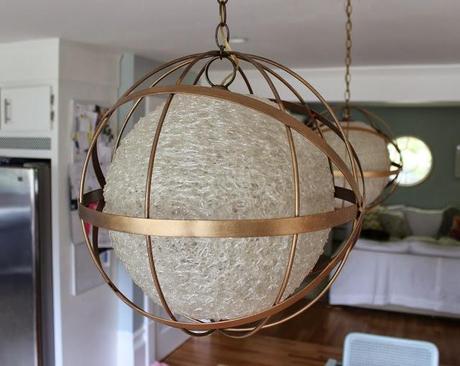 Fancy.
Fancy.
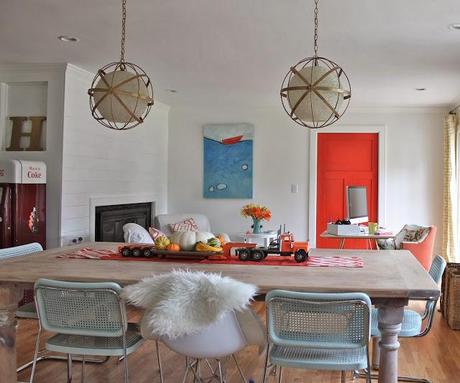 Flip a switch. Fancier. Now we can see our food!
Flip a switch. Fancier. Now we can see our food!
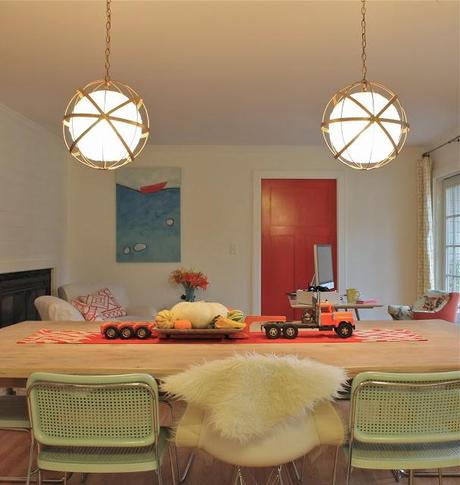 I really hope this post encourages you to try rewiring.
I know it's not for everyone, so use a rewiring service if you have any doubts.
If you are nervous, have someone that knows their stuff (like an awesome Dad or an electrician) give it a look over before installing to make sure you did it right or ask someone to wire it for you while you look on. It takes time to build confidence, so don't be afraid to ask for help.
I really hope this post encourages you to try rewiring.
I know it's not for everyone, so use a rewiring service if you have any doubts.
If you are nervous, have someone that knows their stuff (like an awesome Dad or an electrician) give it a look over before installing to make sure you did it right or ask someone to wire it for you while you look on. It takes time to build confidence, so don't be afraid to ask for help.
Disclaimer: I am not an electrician, although I sometimes play one on the blog. These are basic guidelines. Please use common sense when rewiring fixtures. Always have your power sources and feeds unplugged/shut off when hanging a fixture. Please use quality UL tested materials. Take your time when rewiring and always double check your connections that they are sound and connected properly. And when in doubt, ask an expert or hire an electrician.

